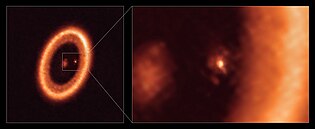
A protoplanetary disk is a rotating circumstellar disc of dense gas and dust surrounding a young newly formed star, a T Tauri star, or Herbig Ae/Be star. The protoplanetary disk may also be considered an accretion disk for the star itself, because gases or other material may be falling from the inner edge of the disk onto the surface of the star. This process should not be confused with the accretion process thought to build up the planets themselves. Externally illuminated photo-evaporating protoplanetary disks are called proplyds.
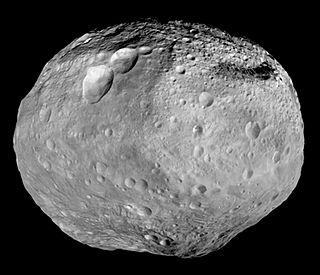
A protoplanet is a large planetary embryo that originated within a protoplanetary disk and has undergone internal melting to produce a differentiated interior. Protoplanets are thought to form out of kilometer-sized planetesimals that gravitationally perturb each other's orbits and collide, gradually coalescing into the dominant planets.

A rogueplanet, also termed a free-floating planet (FFP) or an isolated planetary-mass object (iPMO), is an interstellar object of planetary mass which is not gravitationally bound to any star or brown dwarf.

2M1207, 2M1207A or 2MASS J12073346–3932539 is a brown dwarf located in the constellation Centaurus; a companion object, 2M1207b, may be the first extrasolar planetary-mass companion to be directly imaged, and is the first discovered orbiting a brown dwarf.
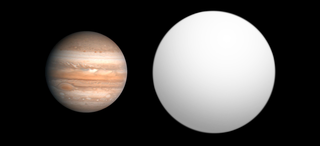
2M1207b is a planetary-mass object orbiting the brown dwarf 2M1207, in the constellation Centaurus, approximately 170 light-years from Earth. It is one of the first candidate exoplanets to be directly observed. It was discovered in April 2004 by the Very Large Telescope (VLT) at the Paranal Observatory in Chile by a team from the European Southern Observatory led by Gaël Chauvin. It is believed to be from 5 to 6 times the mass of Jupiter and may orbit 2M1207 at a distance roughly as far from the brown dwarf as Pluto is from the Sun.
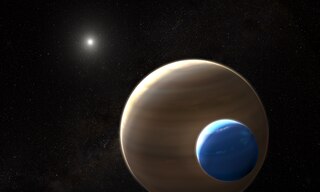
An exomoon or extrasolar moon is a natural satellite that orbits an exoplanet or other non-stellar extrasolar body.

OTS 44 is a free-floating planetary-mass object or brown dwarf located at 550 light-years (170 pc) in the constellation Chamaeleon near the reflection nebula IC 2631. It is among the lowest-mass free-floating substellar objects, with approximately 11.5 times the mass of Jupiter, or approximately 1.1% that of the Sun. Its radius is not very well known and is estimated to be 23–57% that of the Sun.

A sub-brown dwarf or planetary-mass brown dwarf is an astronomical object that formed in the same manner as stars and brown dwarfs but that has a planetary mass, therefore by definition below the limiting mass for thermonuclear fusion of deuterium . Some researchers call them rogue planets whereas others call them planetary-mass brown dwarfs. They are sometimes categorized as Y spectral class brown dwarfs.
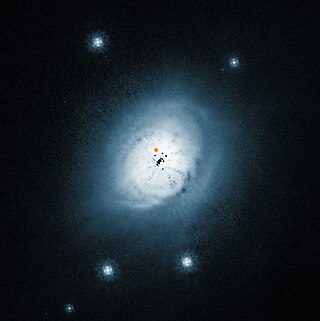
HD 100546, also known as KR Muscae, is a pre-main sequence star of spectral type B8 to A0 located 353 light-years from Earth in the southern constellation of Musca. The star is surrounded by a circumstellar disk from a distance of 0.2 to 4 AU, and again from 13 AU out to a few hundred AU, with evidence for a protoplanet forming at a distance of around 47 AU.

A planetary-mass object (PMO), planemo, or planetary body is, by geophysical definition of celestial objects, any celestial object massive enough to achieve hydrostatic equilibrium, but not enough to sustain core fusion like a star.
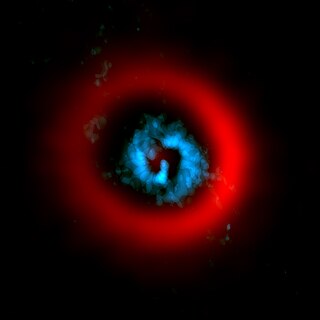
AB Aurigae is a young Herbig Ae star in the Auriga constellation. It is located at a distance of approximately 531 light years from the Sun based on stellar parallax. This pre-main-sequence star has a stellar classification of A0Ve, matching an A-type main-sequence star with emission lines in the spectrum. It has 2.4 times the mass of the Sun and is radiating 38 times the Sun's luminosity from its photosphere at an effective temperature of 9,772 K. The radio emission from the system suggests the presence of a thermal jet originating from the star with a velocity of 300 km s−1. This is causing an estimated mass loss of 1.7×10−8 M☉ yr−1.
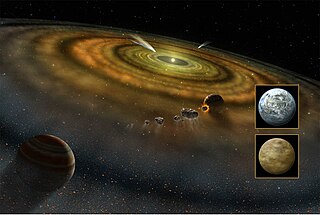
An exocomet, or extrasolar comet, is a comet outside the Solar System, which includes rogue comets and comets that orbit stars other than the Sun. The first exocomets were detected in 1987 around Beta Pictoris, a very young A-type main-sequence star. There are now a total of 27 stars around which exocomets have been observed or suspected.
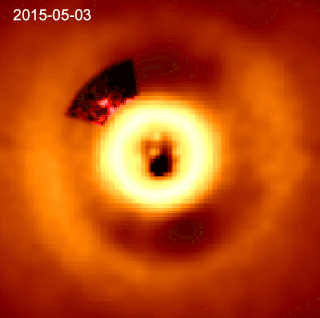
HD 169142 is a single Herbig Ae/Be star. Its surface temperature is 7650±150 K. HD 169142 is depleted of heavy elements compared to the Sun, with a metallicity Fe/H index of −0.375±0.125, but is much younger at an age of 7.5±4.5 million years. The star is rotating slowly and has relatively low stellar activity for a Herbig Ae/Be star.

LkCa 15 is a T Tauri star in the Taurus Molecular Cloud. These types of stars are relatively young pre-main-sequence stars that show irregular variations in brightness. It has a mass that is about 97% of the Sun, an effective temperature of 4370 K, and is slightly cooler than the Sun. Its apparent magnitude is 11.91, meaning it is not visible to the naked eye.

PDS 70 is a very young T Tauri star in the constellation Centaurus. Located 370 light-years from Earth, it has a mass of 0.76 M☉ and is approximately 5.4 million years old. The star has a protoplanetary disk containing two nascent exoplanets, named PDS 70b and PDS 70c, which have been directly imaged by the European Southern Observatory's Very Large Telescope. PDS 70b was the first confirmed protoplanet to be directly imaged.

CI Tauri is a young star, about 2 million years old, located approximately 523 light-years away in the constellation Taurus. It is still accreting material from a debris disk at an unsteady pace, possibly modulated by the eccentric orbital motion of an inner planet. The spectral signatures of compounds of sulfur were detected from the disk.
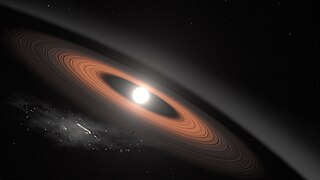
LSPM J0207+3331 is, as of 2023, the oldest and coldest known white dwarf star to host a circumstellar disk, located 145 light-years from Earth. It was discovered in October 2018 by a volunteer participating in the Backyard Worlds citizen science project.
